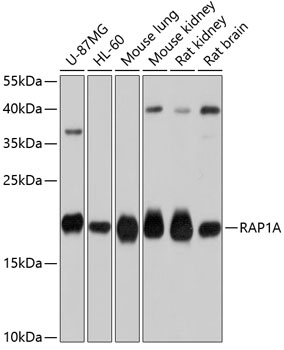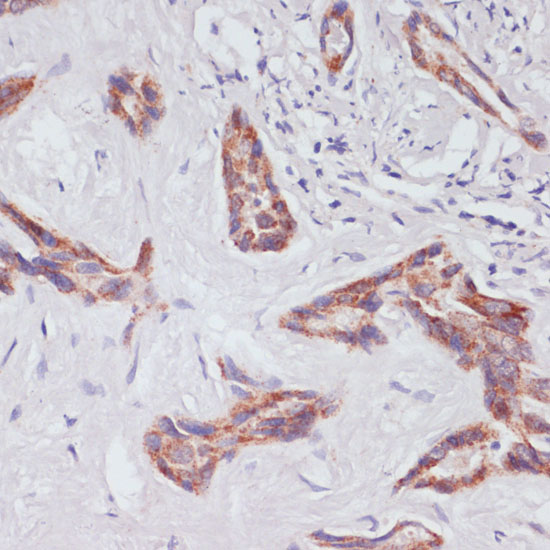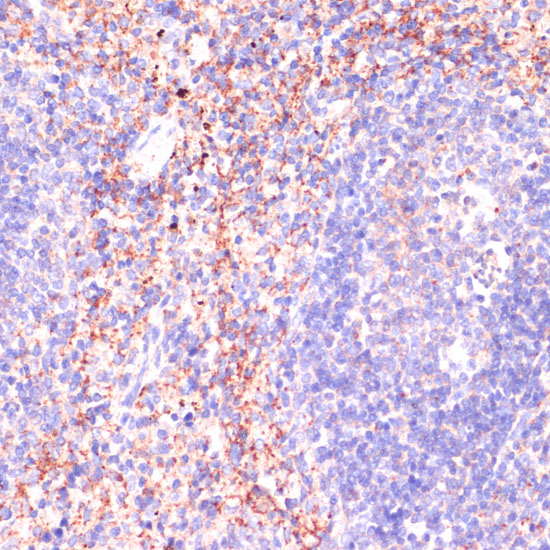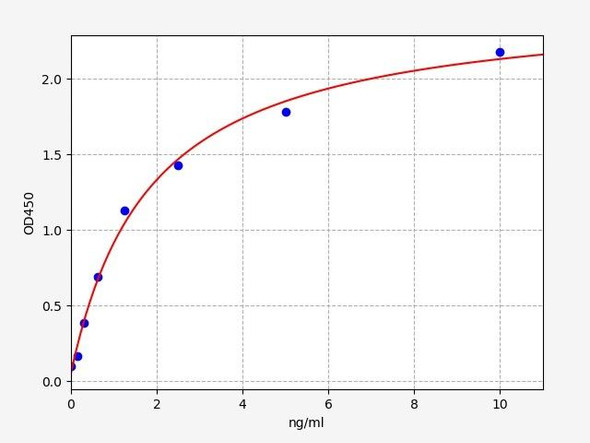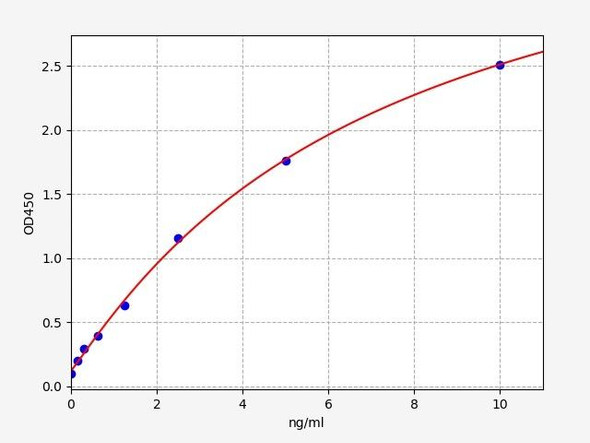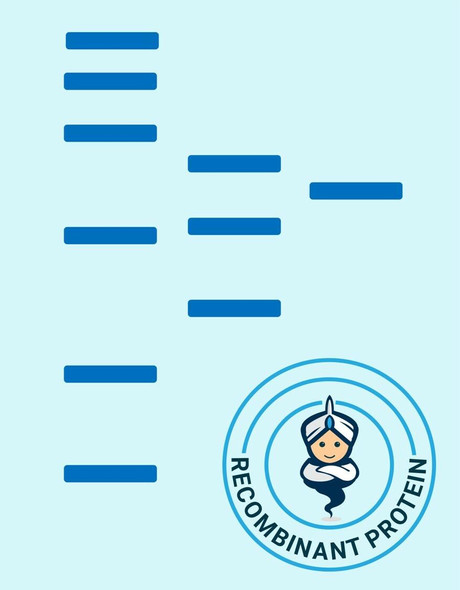Neuroscience
Anti-RAP1A Antibody (CAB0975)
- SKU:
- CAB0975
- Product Type:
- Antibody
- Reactivity:
- Human
- Reactivity:
- Mouse
- Reactivity:
- Rat
- Host Species:
- Rabbit
- Isotype:
- IgG
- Antibody Type:
- Polyclonal Antibody
- Research Area:
- Neuroscience
Description
| Antibody Name: | Anti-RAP1A Antibody |
| Antibody SKU: | CAB0975 |
| Antibody Size: | 20uL, 50uL, 100uL |
| Application: | WB IHC IF |
| Reactivity: | Human, Mouse, Rat |
| Host Species: | Rabbit |
| Immunogen: | A synthetic peptide corresponding to a sequence within amino acids 50-150 of human RAP1A (NP_002875.1). |
| Application: | WB IHC IF |
| Recommended Dilution: | WB 1:500 - 1:2000 IHC 1:50 - 1:100 IF 1:50 - 1:100 |
| Reactivity: | Human, Mouse, Rat |
| Positive Samples: | U-87MG, HL-60, Mouse lung, Mouse kidney, Rat kidney, Rat brain |
| Immunogen: | A synthetic peptide corresponding to a sequence within amino acids 50-150 of human RAP1A (NP_002875.1). |
| Purification Method: | Affinity purification |
| Storage Buffer: | Store at -20'C. Avoid freeze / thaw cycles. Buffer: PBS with 0.02% sodium azide, 50% glycerol, pH7.3. |
| Isotype: | IgG |
| Sequence: | QCML EILD TAGT EQFT AMRD LYMK NGQG FALV YSIT AQST FNDL QDLR EQIL RVKD TEDV PMIL VGNK CDLE DERV VGKE QGQN LARQ WCNC AFLE SSAK S |
| Gene ID: | 5906 |
| Uniprot: | P62834 |
| Cellular Location: | Cell junction, Cell membrane, Cytoplasm, Early endosome, Lipid-anchor, perinuclear region |
| Calculated MW: | 20kDa |
| Observed MW: | 21kDa |
| Synonyms: | RAP1A, C21KG, G-22K, KREV-1, KREV1, RAP1, SMGP21 |
| Background: | This gene encodes a member of the Ras family of small GTPases. The encoded protein undergoes a change in conformational state and activity, depending on whether it is bound to GTP or GDP. This protein is activated by several types of guanine nucleotide exchange factors (GEFs), and inactivated by two groups of GTPase-activating proteins (GAPs). The activation status of the encoded protein is therefore affected by the balance of intracellular levels of GEFs and GAPs. The encoded protein regulates signaling pathways that affect cell proliferation and adhesion, and may play a role in tumor malignancy. Pseudogenes of this gene have been defined on chromosomes 14 and 17. Alternative splicing results in multiple transcript variants. |
| UniProt Protein Function: | RAP1A: a small G protein of the Ras family with tumor suppressor activity. Induces morphological reversion of a cell line transformed by a Ras oncogene. Activated by guanine nucleotide-exchange factors (GEF) EPAC and EPAC2 in a cAMP-dependent manner, and GFR. Counteracts the mitogenic function of Ras, at least partly because it can interact with Ras GAPs and RAF in a competitive manner. Interacts with SGSM1, SGSM2 and SGSM3. |
| UniProt Protein Details: | Protein type:Tumor suppressor; G protein, monomeric; Motility/polarity/chemotaxis; G protein; G protein, monomeric, Ras Chromosomal Location of Human Ortholog: 1p13.3 Cellular Component: neuron projection; perinuclear region of cytoplasm; late endosome; cytoplasm; early endosome; plasma membrane; cell junction; cytosol Molecular Function:GTPase activity; Rap guanyl-nucleotide exchange factor activity; protein binding; Ras GTPase binding; GTP binding; protein complex binding; protein transporter activity Biological Process: platelet activation; microvillus biogenesis; protein transport; nerve growth factor receptor signaling pathway; activation of MAPKK activity; positive regulation of protein kinase activity; energy reserve metabolic process; blood coagulation; signal transduction; regulation of insulin secretion; Rap protein signal transduction |
| NCBI Summary: | This gene encodes a member of the Ras family of small GTPases. The encoded protein undergoes a change in conformational state and activity, depending on whether it is bound to GTP or GDP. This protein is activated by several types of guanine nucleotide exchange factors (GEFs), and inactivated by two groups of GTPase-activating proteins (GAPs). The activation status of the encoded protein is therefore affected by the balance of intracellular levels of GEFs and GAPs. The encoded protein regulates signaling pathways that affect cell proliferation and adhesion, and may play a role in tumor malignancy. Pseudogenes of this gene have been defined on chromosomes 14 and 17. Alternative splicing results in multiple transcript variants. [provided by RefSeq, May 2014] |
| UniProt Code: | P62834 |
| NCBI GenInfo Identifier: | 51338607 |
| NCBI Gene ID: | 5906 |
| NCBI Accession: | P62834.1 |
| UniProt Secondary Accession: | P62834,P10113, |
| UniProt Related Accession: | P62834 |
| Molecular Weight: | 184 |
| NCBI Full Name: | Ras-related protein Rap-1A |
| NCBI Synonym Full Names: | RAP1A, member of RAS oncogene family |
| NCBI Official Symbol: | RAP1A |
| NCBI Official Synonym Symbols: | RAP1; C21KG; G-22K; KREV1; KREV-1; SMGP21 |
| NCBI Protein Information: | ras-related protein Rap-1A; Ras-related protein Krev-1; GTP-binding protein smg p21A |
| UniProt Protein Name: | Ras-related protein Rap-1A |
| UniProt Synonym Protein Names: | C21KG; G-22K; GTP-binding protein smg p21A; Ras-related protein Krev-1 |
| Protein Family: | Ras-related protein |
| UniProt Gene Name: | RAP1A |
| UniProt Entry Name: | RAP1A_HUMAN |


